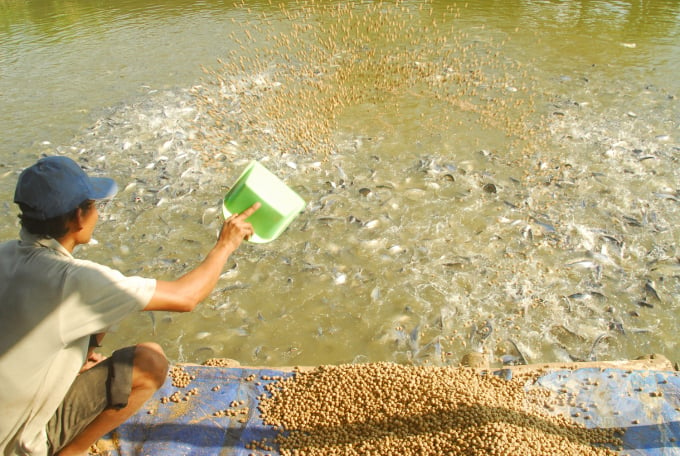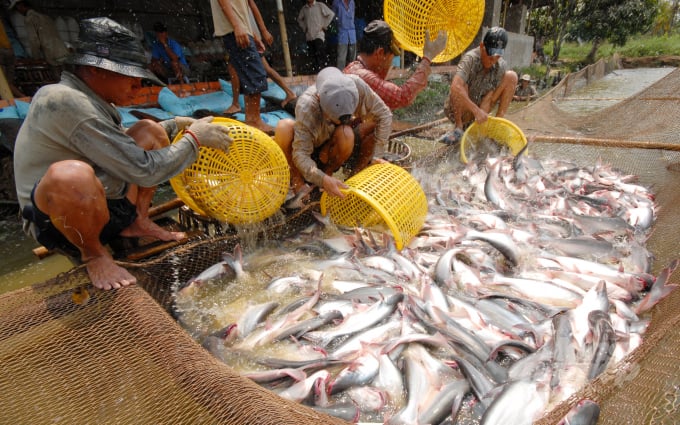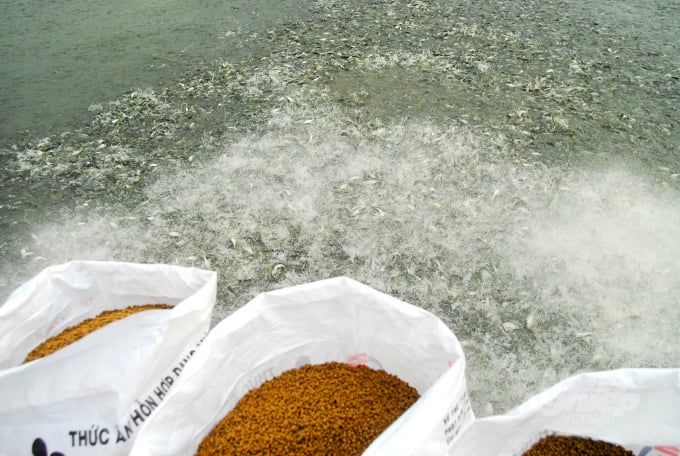November 25, 2025 | 21:20 GMT +7
November 25, 2025 | 21:20 GMT +7
Hotline: 0913.378.918
November 25, 2025 | 21:20 GMT +7
Hotline: 0913.378.918

This is the first time An Giang and Vinh Hoan Corporation (Dong Thap) cooperate to build a circular economy model to increase the value of pangasius. Photo: Le Hoang Vu.
Despite certain difficulties in 2020 and 2021, pangasius remains one of Vietnam’s key export seafood.
In the context that climate change has increased its severe impacts on the Mekong Delta (drought, sea level rise, saltwater intrusion, etc.), An Giang and Dong Thap are still the two provinces upstream with the greatest advantages to develop pangasius cultivation and processing.
With that being the reason, the People's Committees of An Giang and Dong Thap have agreed to submit a proposal to the Ministry of Agriculture and Rural Development (MARD) for consideration and approval. The proposal concerns investment policies with the intention to construct the common infrastructure in the project "Joint production of high-quality pangasius seed at Chanh Sach and Vinh Hoa dunes".
The project has a scale of 500 ha and an estimated total investment of VND 350 billion. The People's Committees of the two provinces also agreed to plan Vinh Hoa and Chinh Sach dunes’ entire area to produce high-quality 3-level pangasius breeds and supply Mekong Delta.

An Giang’s average pangasius farming area is approximately 1,300 ha/year. Photo: Le Hoang Vu.
Through the investment attraction policy of An Giang People's Committee, Vinh Hoan Corporation (VHC) has decided to establish Vinh Hoan Fish Hatchery Co., Ltd.
The headquarters is located in Vinh Buong hamlet, Tan Chau town, An Giang where the corporation currently has its focus on implementing the "Producing 3-level pangasius seed by applying high technology" project. With an area of 48.3 ha, the project aims to provide 1.6 billion spawns and 30 million pangasia per year.
Ms. Truong Thi Le Khanh, Chairman of the Board of Directors of Vinh Hoan Corporation, said, “The Covid-19 pandemic is still complicated. Businesses must first adapt to the current state if they want to develop and survive. They need to change their view on pangasius and reach new heights, especially through developing the pangasius model construction chain following the circular economy.”
VHC has also built a feed factory with a capacity of 350,000 tons/year as well as Mai Thien Thanh Co., Ltd which specializes in producing organic fertilizers to serve crops.
Accordingly, dead pangasius carcasses, sludge during farming, and waste products during fish processing will be collected and processed into organic fertilizer. This approach, together with the in-pond raceway system (IPRS), helps to complete the circular economy model (closed farming and processing without discharging water or waste into the surrounding environment).

VHC currently has its focus on implementing the earliest "Producing 3-level pangasius seed by applying high technology" project in Vinh Buong hamlet, Tan Chau town, An Giang. Photo: Le Hoang Vu.
As shared by Mr. Tran Anh Thu, Vice Chairman of An Giang People's Committee, the People's Committee fully supports the efforts to change and restructure the pangasius industry to raise the products’ value as the way Vinh Hoan Joint Stock Company does.
The province always commits to accompanying businesses and suggests that export seafood enterprises located in An Giang need to build high-tech pangasius farming areas and invest in solar power systems.
Translated by Samuel Pham
/2025/11/24/3536-2-112800_176.jpg)
(VAN) Dong Nai now has tens of thousands of hectares of forests certified for sustainable management, and this area will continue to be expanded in the coming period.

(VAN) Vinh Ha hamlet (Dai Xuyen commune, Hanoi) is shifting away from small-scale farming as households adopt bioscurity into their breeder chicken models.

(VAN) Heavy rains make aquatic species more vulnerable to disease. Proactive water management and high-tech systems help farmers prevent outbreaks and protect yields.

(VAN) Greenhouses are shifting production mindsets in Binh Lu commune, enabling farmers to ‘weather the sun and rain’ and secure stable vegetable harvests throughout the year.

(VAN) Green transition is crucial for the Mekong Delta amid climate change and stricter standards, offering a path toward sustainability.

(VAN) Dong Thap promotes agricultural restructuring, forms large specialized farming zones, raises the value of agricultural products and develops toward ecological and high-tech directions.
/2025/11/22/4018-4-213342_747.jpg)
(VAN) The Mekong Delta Agricultural Experts Club has attracted 143 experts and researchers to participate in providing consultancy and contributing initiatives to the development of one million hectares of high-quality rice.